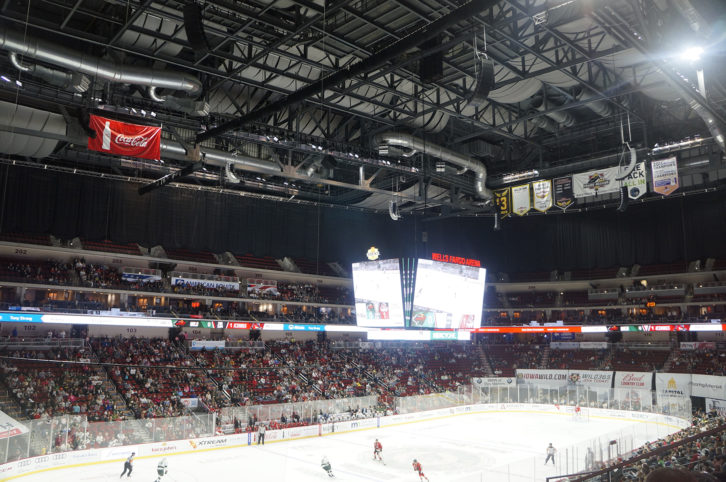
Concerts, NHL hockey, arena football, basketball–you name it, they play it–at the Des Moines Wells Fargo Arena. It’s tough to get the venue to sound right for all of this, but Daktronics Audio Systems Division made it happen; David Sturzenbecher, Applications Engineer and Thijs Hammink, Field Engineer have the story.
SVC: When you say Daktronics, people immediately think of big video screens. But you guys do a lot of very heavy-duty audio jobs and Wells Fargo Arena was certainly one of those. First, let’s get some background. David, tell us about the Daktronics Audio Systems Division.
David: Sure. The audio division of Daktronics does a lot of design/build projects. We do some vid spec projects, but we really focus on design/build for arenas, stadiums, and a lot of other locations that we can support our video product. We’re really getting a lot of video into malls and green spaces. A lot of those systems need audio backing as well.
What was the sound situation at Wells Fargo Arena? They had some existing problems that you had to sort out.
David: Yeah. We actually tested every speaker that we took down and there were a significant amount of failed components within the existing system. Maintenance had been done over the years, but it was just getting time to replace it. There are other areas at the venue, especially throughout the concourses, that the original system just didn’t have any coverage, so our goal was to really fix everything all at one time.
The dead spots surely change depending on the particular event setup. You’ve got the sports, the concerts, so many different things and you had to design a system to make all of them sound right.
David: Yeah, definitely a lot of events going on. A very small installation window, too, just because of the sheer number of events that go through there. So we really had to be very quick with our installation.
Thijs, tell us, what appeared to be the most challenging part of the physical installation?
Thijs: One of the biggest challenges was figuring out how to get the new equipment up to the different locations. The only access to the catwalk where all the amplifiers are is a staircase, and getting all the old amplifiers out and the new ones in was going to be a pretty big task. Luckily for that, we had some amazing subcontractors. The other thing is we had to install a subwoofer stack right in the center above the video board so getting a stack of subwoofers in there while avoiding damage to the video board was definitely a big challenge.
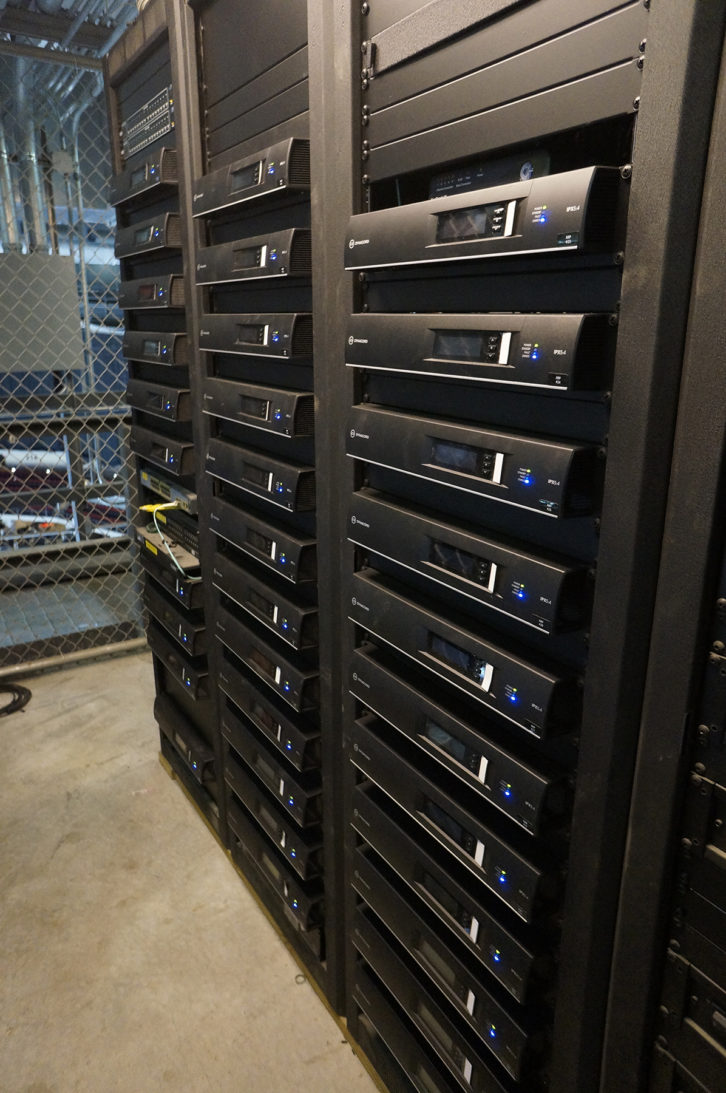 How much of this was pre-assembled elsewhere and brought in for installation, or did you have to assemble all of the various components onsite?
How much of this was pre-assembled elsewhere and brought in for installation, or did you have to assemble all of the various components onsite?
Thijs: In this install everything was pretty much built onsite, everything put together and integrated there. Due to a lot of equipment onsite that was existing, we reused racks and reinstalled new equipment into old locations, which is a little bit different for us. For a lot of our installs we try and manufacture the racks ahead of time and ship them fully assembled.
You did an EASE analysis before you started all of the gripping and sweat work on this. Did that reveal any special problems for a specific sport or event?
David: Yeah, it really did. We do an EASE analysis for nearly all of our installations and we really try to put that engineering work up front to make sure that we’re selecting the right components and getting them in the right locations. With this venue, they play hockey there. Hockey dasher boards can provide an acoustical shadow if you have your speakers located too far inside the ice rink and they’re firing out where they get blocked. So for this installation I chose to push those line arrays out a little more so that there wouldn’t be a shadow. They’re essentially located right over those dasher boards. That caused us to create the array that had over a 90-degree vertical coverage pattern to shoot to the seats all the way in the top and then all the way down to directly in front of the dasher boards.
You primarily used Electro-Voice XLD line arrays?
David: Yeah. These XLD line arrays, they’re not one of the newest Electro-Voice products out there, but they are a very good product that is nice and compact. And that allowed me to get those intermediate angles set properly to get a 90-degree-plus vertical coverage pattern within a rather tight vertical space. One of the complaints from the previous system was that with the speakers blocked the visual of the center-hung videoboard. So that is one of the things that we definitely addressed by our speakers locations to get them up high enough and to make sure they weren’t visually blocking the video screen.
That’s got to be a real challenge sometimes, maintaining sightlines for the video display from everywhere in the arena and still have the speaker arrays hung where the sound is right.
Thijs: Oh, for sure. The trend in centerhung videoboards is bigger, bigger, bigger and as those gain in size they eat up a lot of space that speakers can be placed in. So it does become a balancing act between providing a sound system that accurately covers the venue and putting a videoboard in there that the customer would like.
Those EV speakers are pretty small but they handle a lot of power. I think it’s something like 138dB continuous SPL in a very small package.
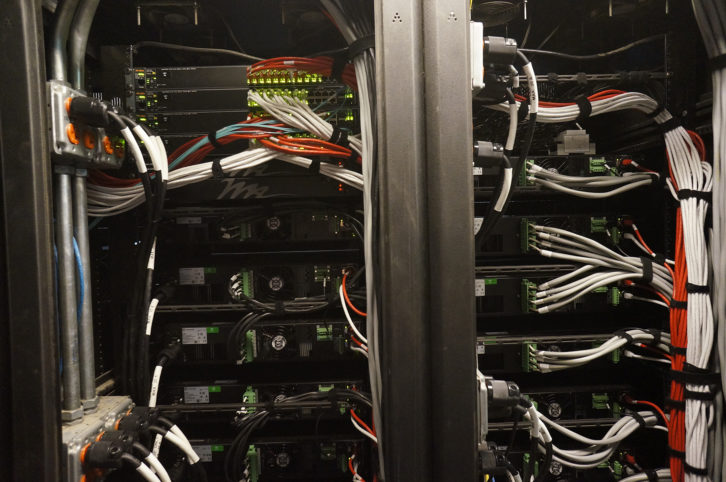 David: They’ve got some output for sure.
David: They’ve got some output for sure.
The venue is pretty symmetrical on one side, but then I think you have a different situation on the other side.
David: Yeah. There’s definitely a drastic change in the venue from one side, which really only has two levels of seating. Near to the opposite side it’s definitely three levels of seating and it extends quite high. So it was a challenge to come up with a model for sure.
You used a lot of different Electro-Voice components.
David: Yeah. There were the XLD speakers. We had EVH fills. There are some fills in the videoboard as well.
And I saw that you gave the announcers an Electro-Voice RE-20 mic?
David: Yeah, that’s a microphone that we use standard on nearly all of our custom jobs. It’s just a great product and it works really well for announcers and podcasters alike.
How much of a time window did you have to get the job done?
Thijs: We had about a month to get most of the system in and get it up and running. Normally in tight timelines we like to keep old systems in place as long as we can and up and running until the new system is in place. But that wasn’t really an option in this one mainly due to the fact that all the equipment was going in place of where the old equipment was–so we had to remove all the old before we could put in the new.
 Were you able to use any of the existing wiring or did you have to just start from zero after you had the old stuff out?
Were you able to use any of the existing wiring or did you have to just start from zero after you had the old stuff out?
Thijs: For a lot of the speaker lines we were able to use quite a bit of existing wiring and analog lines around the facility as well, but where fiber and network is concerned that was all pulled new.
They have to be able to switch over very quickly from one event to another and a big part of that is the amplifiers. Thijs, what amps did you use for this and where did you put those?
Thijs: The main bowl system is amplified by Dynacord IPX Series amplifiers. These are located up in the catwalks in some amp racks up there. And then for all ancillary areas we have some QSC CXD amplifiers and they’re located in different data closets throughout the facility.
As far as the areas outside of the arena bowl, were there places where the previous sound system did not have direct coverage, or did you just upgrade what was already there?
Thijs: There were some areas that had sound coverage, but they had complaints that it wasn’t clear in all locations. And we did add a lot of new speakers in new locations through the different concourses.
Why did you select the Dynacord IPX Series amps?
David: The Dynacord IPX Series amps have the manufacturers’ tunings for them – the FIR drive, processing – that really makes those speakers sound absolutely fantastic. You can get that same process in some of the older EV amps but the Dynacord ones are really kind of the wave of the future for the EV-Bosch product lineup. They do have Dante on board as well as kind of an undocumented feature they’re calling Ghost Power; in the event of a power failure, the DSP stays active for about 20 seconds. When power is restored, the amp starts passing audio in about four seconds. That’s quite a bit faster than some of the competitors’ amps that can take over two minutes to start passing audio in the event of a power failure. And when you’re looking at these big venues that have the sound system augment the life safety system, you know every second matters.
David: The Dynacord amps also have a really nice Q-SYS plugin. We did use Q-SYS for our DSP processing in the venue, so with this plugin we can monitor those amplifiers through the Q-SYS platform; we are running redundant Cores on redundant UPSs to really try to mitigate any downtime that there might be.
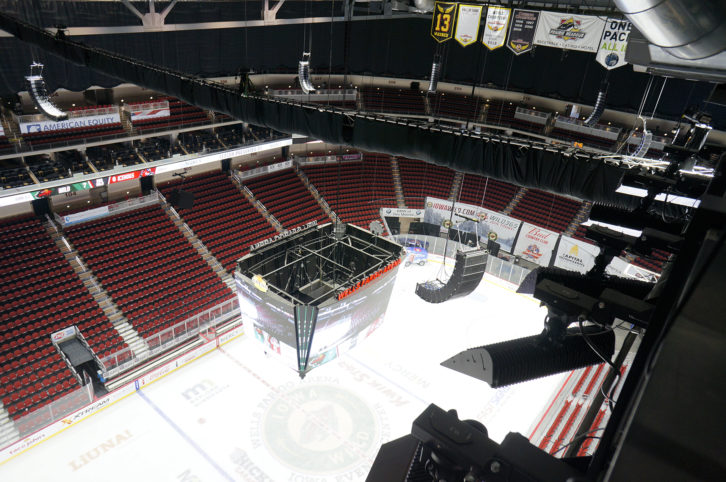 And you used Dante sound distribution. How did you get that set up?
And you used Dante sound distribution. How did you get that set up?
Thijs: We’ve got Dante distribution running on redundant star networks. So we’ve got two central core switches that distribute to additional switches located throughout the facility. Those also run the Q-LAN network, so in the different bar areas and interview rooms we’ve got some Q-SYS touch screens and there’s Dante connection points in all those locations as well.
Some of the other areas outside the arena didn’t have direct sound coverage before. How did you cover those as far as the speakers you used?
David: Yes, in the bar areas we really upgraded the sound. We added dedicated systems. As Thijs said, there are dedicated touch screens in there and Bluetooth input jacks, but we also did add some Electro-Voice EVID speakers. We did add some subwoofers for those bar areas to provide some low-end energy and really augment those areas. We also added some speakers to the interview room, and another touch screen there so it can all be run locally as well.
In the bar areas, how do they control the sound system there?
Thijs: Each bar location has their own touch screen and the staff has access to do different source selections based on radio and media players, arena events, or local Bluetooth input. And they can adjust volume and sources as they like.
They have an interview room there as well. That’s not the same as the broadcast booth is it?
David: Oh, no, no. The interview room is basically a room where after an event the coach will come and give his analysis of the game. So we did upgrade the sound in the interview room as well.
Were those ceiling speakers you put in there?
 David: Yeah. Yep. They’re Electro-Voice EVID ceiling speakers.
David: Yeah. Yep. They’re Electro-Voice EVID ceiling speakers.
Were any changes made in the broadcast announcer’s area?
David: Yeah. We supplied a Studio Technologies Dante-enabled announcer’s interface box that seamlessly ties into the Dante network, again with that RE-20 mic that we mentioned earlier. And I think that really did help bring forth that announcer so it’s nice and clear and crisp.
And what kind of mixer did you use for overall control in the arena?
David: There are a handful of mixers in this project. The main front-of-house mixer is a Yamaha CL5 that does the main in-venue routing and level control. But there’s also a Yamaha QL5 that routes video signals and does a lot of back-of-house mixes. And then there’s also a QL1 that they have as a portable mixer, but we put in a rack that they can wheel to different rooms. For the different events, whether it be basketball or hockey, sometimes they want to control the sound from the floor, and sometimes they want to control the sound from one of the press booths. So that gives them the flexibility to really control the sound from anywhere. There are actually eight Yamaha RIO boxes that are Dante-enabled in this installation and most of them are around the floor to provide event-level inputs. We do have another one in the control room and then there are two mobile racks. Again, they can push those two input/output racks to wherever they need to tie in some analog sources.
What was the toughest part of this thing? Was it just the tight timeline or did anything unexpected come up?
Thijs: I wouldn’t say there’s a lot that was unexpected, but with a lot of the existing equipment that’s in there – they have a lot of existing video equipment, some existing audio equipment – that all had to get reintegrated, including the patch bays. We ended up having to rewire entire patch bays and everything. That took up a lot of time.
What kinds of projects does Daktronics Audio Systems Division have coming up?
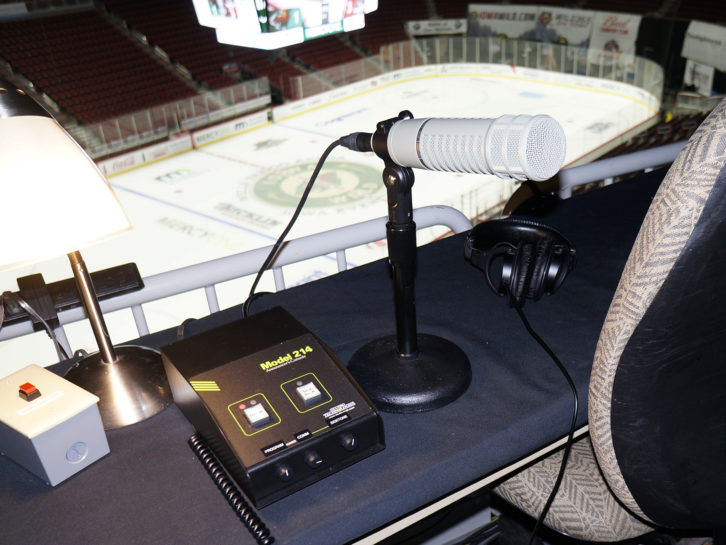 David: We definitely are in the middle of quite a few nice projects. We’ve got a University of South Alabama Football that’s currently in the middle of an installation as well as one of our nice clients, Kansas State Football, which we’ll be kicking off here shortly.
David: We definitely are in the middle of quite a few nice projects. We’ve got a University of South Alabama Football that’s currently in the middle of an installation as well as one of our nice clients, Kansas State Football, which we’ll be kicking off here shortly.










